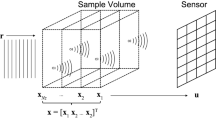Abstract
A digital in-line holographic particle tracking velocimetry (HPTV) system was developed to measure 3D (three-dimensional) velocity fields of turbulent flows. The digital HPTV (DHPTV) procedure consists of four steps: recording, numerical reconstruction, particle extraction and velocity extraction. In the recording step, a digital CCD camera was used as a recording device. Holograms contained many unwanted images or noise. To get clean holograms, digital image processing techniques were adopted. In the velocity extraction routine, we improved the HPTV algorithm to extract 3D displacement information of tracer particles. In general, the results obtained using HPTV were not fully acceptable due to technical limitations such as low spatial resolution, small volume size, and low numerical aperture (NA). The problems of spatial resolution and NA are closely related with a recording device. As one experimental parameter that can be optimized, we focused on the particle number density. Variation of the reconstruction efficiency and recovery ratio were compared quantitatively with varying particle number density to check performance of the developed in-line DHPTV system. The reconstruction efficiency represented the particle number distribution acquired through the numerical reconstruction procedure. In addition the recovery ratio showed the performance of 3D PTV algorithm employed for DHPTV measurements. The particle number density in the range of C o = 13–17 particles/mm3 was found to be optimum for the DHPTV system tested in this study.













Similar content being viewed by others
References
Baek SJ, Lee SJ (1996) A new two-frame particle tracking algorithm using match probability. Exp Fluids 22:23–32
Barnhart DH, Adrian RJ, Meinhart CD, Papen GC (1994) Phase-conjugate holographic system for high-resolution particle image velocimetry. Appl Opt 33:7159–7169
Coppola G, Ferraro P, Iodice M, Nicola SD, Finizio A, Grilli S (2004) A digital holographic microscope for complete characterization of microelectromechanical systems. Meas Sci Technol 15:529–539
Cowen EA, Monismith SG (1997) A hybrid digital particle tracking velocimetry technique. Exp Fluids 22:199–211
Hermann SF, Hinsch KD (2003) Light-in-flight holographic PIV (LiFH–PIV) for wind-tunnel applications: off-site reconstruction of deep-volume real particle images. In: Proceedings of international workshop on holographic metrology in fluid mechanics Loughborough, UK, 28–30 May 2003
Koek WD, Bhattacharya N, Braat JM (2005) Influence of virtual images on the signal-to-noise ratio in digital in-line particle holography. Opt Express 13:2578–2589
Kukrer O, Hocanin A (2006) Frequency-response-shaped LMS adaptive filter. Digit Signal Process 16:855–869
Malek M, Allano D, Coëtmellec S, Lebrun D (2004) Digital in-line holography: influence of the shadow density on particle field extraction. Opt Express 12:2270–2279
Meng H, Hussain F (1995) A in-line recording and off-axis viewing (IROV) technique for holographic particle velocimetry. Appl Opt 34:1827–1840
Meng H, Anderson WL, Hussain F, Liu DD (1993) Intrinsic speckle noise in in-line particle holography. J Opt Soc Am A 10:2046–2058
Pan G, Meng H (2003) Digital holography of particle field: reconstruction by use of complex amplitude. Appl Opt 42:827–833
Pu Y, Meng H (2000) An advanced off-axis holographic particle image velocimetry (HPIV) system. Exp Fluids 29:184–197
Schnars U, Juptner W (1994) Direct recording of holograms by a CCD target and numerical reconstruction. Appl Opt 33:179–181
Sheng J, Meng H (1998) A genetic algorithm approach for 3D velocity field extraction in holographic particle image velocimetry. Exp Fluids 25:461–473
Takehara K, Etoh T (1999) A study on particle identification in PTV particle mask correlation method. J Vis 1:313–323
Ushijima S (1996) Particle tracking velocimetry using laser beam scanning. J Hydraulic Coast Environ Eng JSCE 539/II-35:99–107
Yang W, Kostinski AB, Shaw RA (2005) Depth-of-focus reduction for digital in-line holography of particle fields. Opt Lett 30:1303–1305
Zajtsev AK, Linb SH, Hsu KY (2001) Sidelobe suppression of spectral response in holographic optical filter. Opt Commun 190:103–108
Acknowledgments
This work was supported by the Korea Science and Engineering Foundation (KOSEF) through the National Research Lab. Program funded by the Ministry of Science and Technology (No. M10600000276-06J0000-27610).
Author information
Authors and Affiliations
Corresponding author
Rights and permissions
About this article
Cite this article
Kim, S., Lee, S.J. Effect of particle number density in in-line digital holographic particle velocimetry. Exp Fluids 44, 623–631 (2008). https://doi.org/10.1007/s00348-007-0422-z
Received:
Revised:
Accepted:
Published:
Issue Date:
DOI: https://doi.org/10.1007/s00348-007-0422-z




